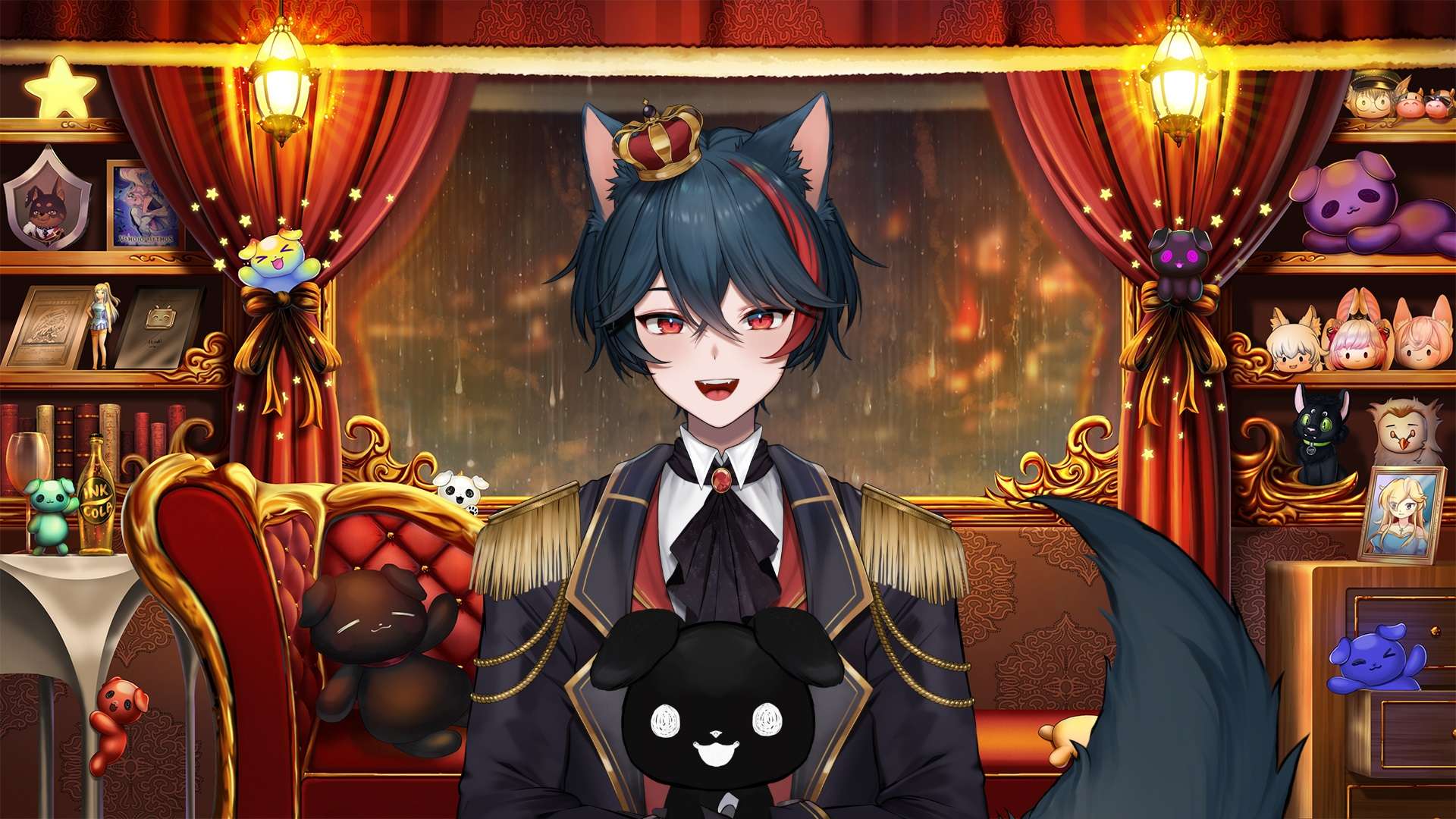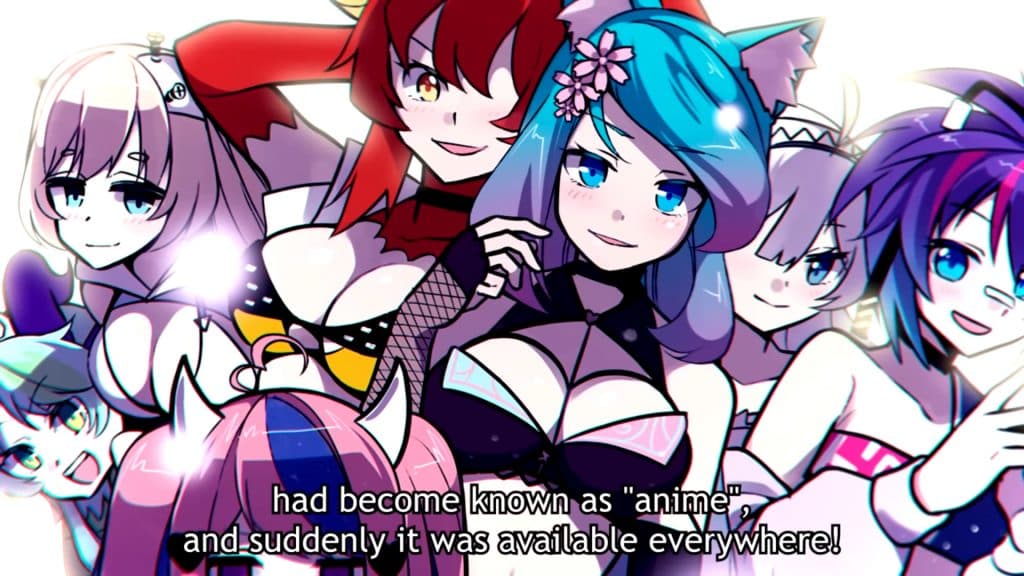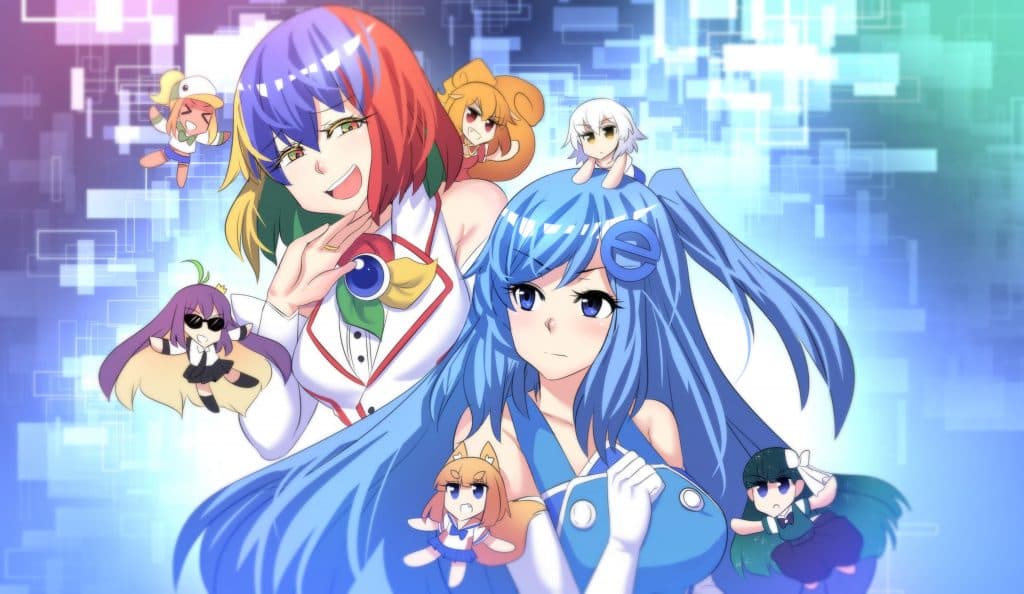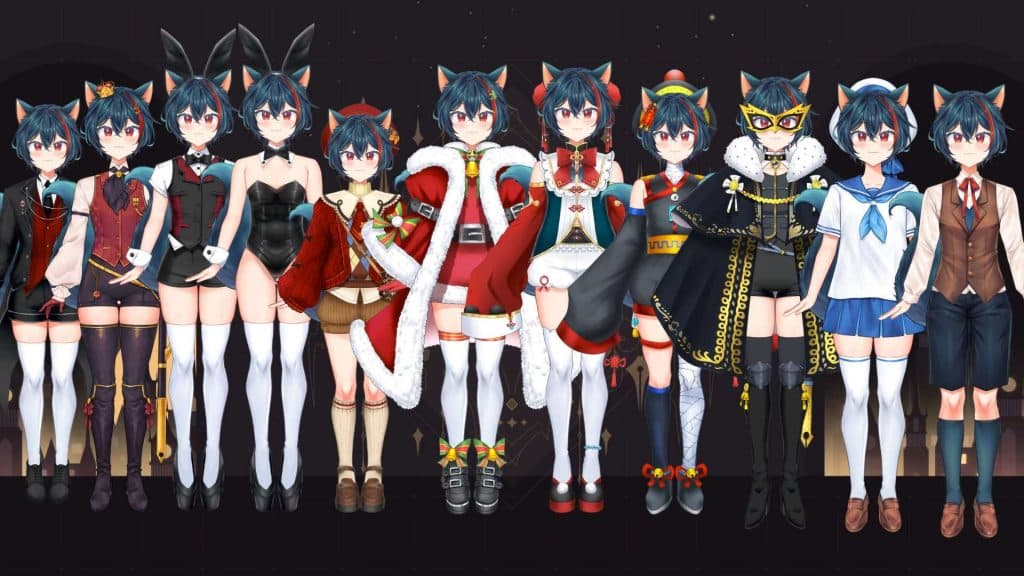Merryweather brought webcomics back to life, then VTubing came along
 Supplied: Merryweather
Supplied: MerryweatherLucius Merryweather has worn many hats. He’s an author, webcomic creator, and now a VTuber. However everywhere he’s gone, he’s left a legacy of innovation in his wake, reviving and revitalizing online storytelling forever.
If you’re on the ‘anime side’ of Twitter, Merryweather will be a name you’re probably familiar with.
You might not follow him, but his comics are quoted by many on a daily basis. He probably get retweeted onto your feed, with each new drop cresting tens of thousands of likes. The biggest hits in the hundreds of thousands.
His personal Twitter account, focusing on his VTubing more nowadays, has a following nearing 400,000. His brand account, Merryweather Media (in his name but certainly not solely his own), has more than a million.
Iconic characters like Nintendo Switch-chan — an anime personification of the console — still deck the halls of conventions across the world. That’s years on from her debut as just a ‘meme character’ in his broader creative universe.
But the truth is Merry can’t draw.
He isn’t the artist, but the writer (and in many cases the mind behind the short 4-koma, or four-panel, style comics his studio produces). That doesn’t make his spirit any less creative. In fact, it made him more industrious with how he got into internet fandom, and then stardom, in the first place.
When we spoke, he was walking around his hometown in Denmark. He was visiting for a couple of weeks while he awaited his visa to return to work in Japan. Nature was rustling in the background as he regaled stories of every aspect of his life.
From the first words he said on that two-hour call it was evident he was born to be a storyteller. The biggest challenge was getting started in the first place.
“Denmark is a small country, there were only a few thousand visitors to these annual conventions, but it was the first time for me to really get into and experience anime in this way,” he told Dexerto, recounting his first con experience back when he was 14.
“What I saw when I entered this anime convention was spectacular. There were a large number of people who liked exactly what I liked, who cosplayed characters I knew from anime, and there were events based on things I knew about. It was the first time I really related and felt a part of something in a larger way.
“I was standing there and I was feeling a part of it but I didn’t know what to contribute. I’m not a cosplayer, I’m not an artist, I’m not making anything. I’m not a gamer.
“I thought to myself ‘if I’m to be here, I need to make some effort to be part of this environment.’ It’s a magical experience and I want to be part of it. I thought, what can I do? I can write.”
Writing is one thing, but people don’t go to anime conventions to read light novels. In fact, light novels have fallen by the wayside in media since peak popularity in the late 2000s and early 2010s.
He didn’t have any money. Merry’s parents paid for his bus ride there and back, and enough to get into the convention. That alone was a big ask. He didn’t even know what a commission was at that time to get some art and bring his stories to life.
But that didn’t stop him from trying, walking around the artist alley and asking anyone from the 11 tables there to draw his ideas.
“I went up and asked [the first person] ‘can you draw my manga? I’ve written a story.’ She said ‘no, why would I do that,’” he scoffed.
“She started explaining how she’s been to Japan, pitched to Shonen Jump — she started telling me about her career, basically to say ‘hey little teenage boy, f**k off.’
“I then took one step to the left and asked the guy next to her. His name was Joakim Waller and he is also a Swedish manga illustrator, part of the same studio. “It was a bit silly in hindsight, but he was too polite and perhaps too shy to say no.
“His response was ‘maybe someday.’ That was good enough for me.”
It wasn’t a perfect plan, but it set the wheels in motion for Merry.
 VShojo / Merryweather Media
VShojo / Merryweather MediaThe rise of webcomics online
Merry didn’t realize it at the time, but he was trying to break out into the webcomics scene.
Webcomics were massive in the days of the early internet. XKCD, Cyanide and Happiness, Ctrl+Alt+Del and many others had taken forums by storm, and set the bar for early meme culture.
It wasn’t seen as a serious pursuit though. At the time, artists like Waller were trying to get that lucrative manga publishing deal. Even if they weren’t Japanese, there was still a growing demand for print manga. Webcomics, the “newspaper-style comics on the internet”, was in a lull of popularity.
Merry tried for months to get Waller on side though, pestering him with scripts. After nearly a year it paid off. He got Joakim onboard for a print deal in a Danish manga magazine called Comic Party. They were paying around $200 a chapter, or around 50 pages of work. The two got to work and had a polished story ready for release.
Then, the volume before they were expected to publish, the magazine was liquidated. They ran out of money, and the work they did went down the drain – almost.
Merry turned to a website called mangamagazine.net. Waller was burned out by the entire process and swore to never return to webcomics, but agreed to publish the work because there was nothing else to do with it.
He uploaded it, bit by bit, garnering a small following in the process. When the content ran out, he had to find other ways to keep publishing.
“I would be able to save up enough money from my allowance to find a way to order a comic,” he laughed.
“I remember my mom was very upset at me because she thought I was getting scammed. She saw on my account that I was sending money to various artists… she didn’t know what I was getting out of it.
“Most people, if their 16-year-old son was sending hundreds of dollars to foreign countries, you’d stop and think ‘what’s going on here?’ I tried my best to explain it to her, she kind of struggled to understand how much they cost and why I’d be spending money on that.”
This was a strategy Merry followed for years. He had his stories like The Steam Dragon Express, Tale of a Time Wizard, Crimson Gain, Magical Police Girl. Every six months he’d order a batch of one-shots with his allowance and publish them slowly.
 Merryweather Media / Ruretto
Merryweather Media / RurettoBut then he saw Lucky Star. The 4-koma format was all the rage. But beyond its punchiness, he saw it as a way to stretch out bang for his buck.
This led to his first hit story called Magnolia Online, something he described as “Lucky Star meets Sword Art Online”. He created it with Filipino artist Power-J.
“Everything you see me doing now — Internet Explorer-chan, Goth Girl and The Jock — it all stems from this one moment where I wanted to try and save money and get more frequent updates with Magnolia Online.
“By switching to four-panel comics, it let me publish at an increased frequency, and it set the foundation for what I’d later consider the thing that made our studio popular.”
From there it snowballed.
Merry was able to earn a little bit of money through various deals with the 4-koma publishing. He also got a job as a telemarketer at a Danish phone company, and all of his disposable income went into making comics.
He had earned enough that he moved to Japan on a working holiday visa for a short while, and it kept paying off.
“Knowing I wasn’t going to earn as much money in Japan than Denmark, I prepared for it because I knew I wouldn’t afford making comics to that level, but I still wanted to continue.
“We started up a Patreon for The Crawling City [with artist Paroro]. I just wanted $400 a month. If I could get $400, I could do 4 panels a week, continue the comic, pay the artist and that was it.
“It ended up being $1200 a month which was great because I could make even more comics.”
Evolving with the times
Merry wasn’t the only person doing 4-koma manga like this to share on various platforms, but he was the one who proved it could be successful.
It was a calculated decision, even if there was a bit of luck involved too. People had gone from reading manga on their desktops to mobile. But there was an inherent problem with that.
“I don’t know if you’ve tried to read manga on your phone, but you need a very big phone for that to be a good experience. You need to zoom in on each panel, it’s not fun.
“My comics were able to be read on phone, they fit perfectly because they were vertical. My vertical comics were able to be enjoyed in a way that a lot of my colleagues’ work weren’t.”
While a lot of his contemporaries pushed forward with the full manga style, Merry’s more accessible and digestible stories took off. Apps like Webtoon elevated the medium further, and with it, the industry had to evolve.
The 4-koma style, or the infinite-scrolling manhwa (Korean manga) style is now the gold standard for webcomics and most digital manga.
But it wasn’t the formatting alone that made Merry a household name in the space. He found a way to keep up with his audience, tapping into meme culture with series like Internet Explorer-chan, a story illustrated by Princess Hinghoi which personified the clumsy web browser and its rivals.
“When we posted Internet Explorer-Chan, something kind of changed. [It] blew up to an immense degree. The first chapter got over 10,000 retweets, which was crazy at the time.”
“Internet Explorer-chan was meant to be a one-off, an experiment. But it became so popular that we could not resist making it a full series.”
 Merryweather Media / Princess Hinghoi
Merryweather Media / Princess HinghoiMeme comics became Merry’s schtick for a while. Stick Bug-chan and Moth-chan were two such characters following in the same vein of taking absurdist youth humor, personifying the concepts into anime girls, and making even more memes out of it. Simply, it was called ‘Meme Girls‘.
The payoff in terms of engagement soon turned into the first bit of vitriol he faced online for his works, years into his career. The tides changed where the memes were too much and ended up dividing his audience.
“I remember my surprise when I was reading the quote retweets of our comics where there was a lot of vitriol all of a sudden. I tried to tackle this in a few different ways, but it’s mostly gone away now.
“They disappeared when we stopped focusing on memes and started on narrative comics again like Goth Girl and the Jock.”
He also found creative ways to keep pushing his work, using some of the industry’s worst-kept secrets to boost his popularity (and notoriety).
“I had this philosophy — which I still have today — is you should post everywhere you can. Even if it’s one person seeing it, that’s an extra real human who can become part of the community.
“I was struggling to figure out where the piracy sites stole their comics from, but I found them and started posting them pretending they were Japanese comics, and all the piracy sites bots stole it. It gained us thousands of dedicated readers who still follow us to this day.
“I’ve had some people discuss the ethics of that, and I thought about it a little bit, and I came to the conclusion I don’t see an issue with it. We didn’t condone piracy.
“What I did back then was a good thing because it converted a lot of people who were reading pirated manga into reading Webtoon and official webcomics. There was a whole world of legal manga that didn’t have eight malware p*rn ads next to it that you could easily go and enjoy in convenience.”
Setting up Merryweather Media
All these successes, and no shortage of stories, led Merry to create his own studio.
Using artists he had worked with for years, he started Merryweather Media. He would be the CEO and lead writer, hiring writers on salary — not just contracts — to keep creating the comics that made them all famous.
“I have a lot of artists I work with and communicate with in their own unique ways. They’re very unique people, it’s a fun challenge, and we have a little family going on in the studio. We have about 12 full-time artists working with us, and they have their own quirks. I enjoy it a lot.”
This brings us back to the aforementioned Joakim Waller. After going his own way to try and make print manga a career, he has returned to work alongside Merry, 10 years later, on projects such as VShojo Mythos.
“He was still trying to make comics… but he never got paid very well for it because print manga doesn’t pay very well,” Merry explained. “I asked him what he was doing now, and he said he was working at a meat packing factory and getting paid pennies.
“I said I’d double that and told him to come back to art full-time, do webcomics with me,” he said, getting incensed at rehashing the details. “His art is worth so much. It was a crime against humanity when I heard his story. He even got a back problem from working there. It was awful.”
Merry is proud to pay his artists a salary. Gone are the days when he roamed Danish conventions and their artist alleys with not a penny to his name. He offers thousands of dollars a month, mostly to artists in South East Asia and other less-wealthy areas with nevertheless skilled creators, to draw his viral comics.
He has secured some major brand deals. He has written stories for Discord and is one of Webtoon’s most successful creators. VTubers can’t get enough of his art, whether it be in the form of 4-koma manga or lore videos. It’s not a mega profitable enterprise, but merch and other forms of monetization are keeping it afloat.
And while it’s hard to convince people to spend their $10 here instead of on a big-name subscription service, there’s a dedicated audience who do.
“A lot of creative fields, they don’t traditionally pay super well. It’s hard to make money off these fields.
“People have to realize when you’re in the entertainment business, you’re competing with massive corporate giants. A lot of people spend their money on going to the movies, Netflix subscriptions, and places where you get the most bang for your buck.
“Being an artist who draws funny stuff or makes meme comics, asking for $10 a month is a big ask. There are people willing to pay for it and people who do, and it’s great there are those people who want to support artists. You can get a more unique experience. But we are definitely outgunned by big corporations, even in the anime field.
“A $10 a month Crunchyroll subscription is going to get you access to as many 20-minute anime episodes as you’d want. If you’re reading a comic from our studio, you get 10 panels per episode — and while I think we provide a good quality thing, it’s definitely niche.”
VTubing and finding a different audience
The transition from webcomics to VTubing was a pretty natural one to Merry. While he hasn’t abandoned webcomics entirely — or even predominantly — the virtual content creation world has opened up previously unimaginable channels of expression.
For once, he doesn’t really get misconstrued as the artist behind his work. What he can create on stream is similar to the stories he weaves through his writing. The imagination shines, just in a different way.
There are many familiar faces in the medium too. Many of the voice actors Merry has worked with over the years to narrate some of his works, like Jonah Scott, are now VTubers. Creators like Lost Pause and AkiDearest, who were popular in the same circles as Merry, brought awareness to the medium.
“It has been the same ecosystem that has evolved throughout the years,” he explained. “People have come and gone.
“VTubing is a natural escalation I find. People are becoming anime characters — we’ve talked about them long enough, now we’re becoming them.
“There’s Takahata101 who used to be in Dragonball Z Abridged and now he is a VTuber himself. A lot of these people, characters, they reoccur and it’s fun to see the evolution of everything. It makes me wonder what things will look like in 20-30 years if it’s going to continue.”
He was an early viewer of Kizuna AI, and wanted to get on the train early to launch an English VTuber. But there were limited resources at the time.
It wasn’t until Project Melody that he felt inspired to try again.
“She was making headlines all over the place and caused the whole VTubing revival in the west,” he said.
“She got pushed a lot in the mainstream media, and then a lot of other VTubers came out of the woodwork like Zentreya, Ironmouse, and stuff. The whole VShojo crew popped up around then.”
He had an actor and everything lined up for the first VTuber project he tried before that fell apart. For this second time around, close friend Lumi was the catalyst for it all — except this time, he would become the streamer.
“I remember she was like ‘we could try that.’ I needed a girl who had acting experience to be a VTuber, and then we were able to get it started.
“Originally I was just Lumi’s mod, watching and giving advice behind the scenes, and then she was able to take over on her own, we switched over to Twitch, and then I also became a VTuber.
“I was texting a Japanese artist and asked about getting an illustration for Lumi. They gave me the prices for their Live2D models, and so while they misunderstood me, I took it as an opportunity to get my own Live2D. That’s how I became Merry the Dog.”
 Supplied: Merryweather
Supplied: MerryweatherVTubing for Merry isn’t just a different way of streaming. It’s an entirely different form of content creation from webcomics. It serves a different purpose, and taps into an audience he previously couldn’t reach.
“Our main problem as a studio is everything we do is hand drawn, stuff we have to produce. There’s no way for us to reasonably mass-produce content. VTubing, as long as you have the model ready and done, you can mass-produce content five hours a day.
“It gives people a lot to chew into, and it builds a very strong community which we were never capable of doing with our comics — at least to that level. We’ve had people who are dedicated readers and fans, but it’s been a secondary thing.
“We have people’s part-time attention [with comics]. With VTubing, there’s the potential of having their full-time attention, and that’s what I consider valuable.”
Bringing storytelling into VTubing
His storytelling ability isn’t just limited to the webcomic form. VTubers, with their plethora of own stories, invites Merry to put his own creative touch on his things.
While lore’s place in VTubing is hotly disputed, for him it’s just “fun”.
He and his studio have worked on major videos for the whole of VShojo, NIJISANJI’s XSOLEIL branch, and Hololive’s Mori Calliope. He’s currently republishing a webcomic series with NIJISANJI star Vox Akuma. Various indie talents have procured his services too, and fans can’t get enough.
“It gives people an opportunity to see these characters they might have grown attached to in situations that would be difficult to put in a stream.
“Something like VShojo Mythos is like you’ve got the actors, you watch their show, now watch a movie where they play their characters with a fully-fleshed narrative. Ironmouse in a stream, it would be very difficult to visit hell and engage with all the different characters and have full-scale battles.
“I know some VTubers play around with the theatrical stuff, but you can’t do it fully-fleshed. Lore videos and stories based on VTubers bring the opportunity to do things like that, that you cannot do in a stream environment.”
VShojo Mythos is probably the most expansive of the projects. It’s Marvel Cinematic Universe meets VTubing. Nearly every single member of the agency has received a video at some point in time. Some, like Ironmouse, have gotten multiple.
“It started out being Nyanners and Ironmouse getting lore videos. They both requested me for them because Nyanners knew I did eldritch horror and Ironmouse had seen Mori Calliope do a short video series with us.
“I got a message two weeks before her debut asking to do a lore video for her. That was hardly any time, so I was like all hands on deck, we’re going to do an 18-minute-long lore video. There was some apprehension at the beginning about taking the story too seriously, but I think everyone really liked the video.”
Thanks to Mythos, Merry became a household name in the VTubing realm, and he felt like a Hollywood star.
“It was very Hollywood vibes,” he laughed. “I got to go to Anime Expo, be behind the scenes during Kson’s reveal, me and Lumi. Overall I just enjoyed my experience with them.
“I think a lot of the lore climaxed when Melody got her video, because that gave mainstage to a lot of different members. It was 30 minutes long, and it was a big deal. I lost money on that one. They gave me the same budget on each of them, but we often go above and beyond.
“With a lot of the members leaving, it was a privilege to be their writer, and I think we managed to do something pretty great and unique, and it’s something people are going to remember forever.”
Merry’s VTubing journey, much like his webcomics start, set the standard. Now lore videos are a frequent addition to any budding streamer’s debut. They might not have the same production quality as one of his own epics, but more are tapping into their own creativity and telling stories their own way.
For him, he now enjoys a new way to express himself online. No longer is he the misunderstood author of some corny meme comics. People get to watch him play games, or hear his stories for hours — much like he did with me walking around aimlessly in Denmark.
It keeps him on his toes, and keeps his mind fresh.
“I don’t like only doing one thing at a time because it burns me out. That’s why I like doing multiple comics.
“VTubing is the same. It’s an opportunity to do something that isn’t just writing comics and I value it greatly because of that. It gives an opportunity for people to get to know me, not just through what I write.”
As our conversation wound down, I asked him how he had time for everything. Between being a CEO, an acclaimed writer, and streaming five hours a day, there’s not a lot of spare time. But his creativity keeps him going, it’s a machine that feeds itself.
But after sharing his stories through this fantasy lens, and even dolling up online as a virtual character, VTubing has let him showcase a bit of his authentic self.
“On the webcomic side, people have a lot of ideas on who I am. I remember there were people online who said ‘I thought he was a neckbeard.’
“I’m kind of a weird person though. I don’t fall under any particular stereotype. I’m from Denmark, my mum is a Turkish immigrant, my dad was a taxi driver.
“Some people think I come from a really rich family and that’s how I was able to afford making a webcomic studio. No, not really. I’m just a weird European.”


